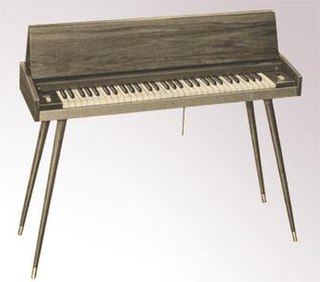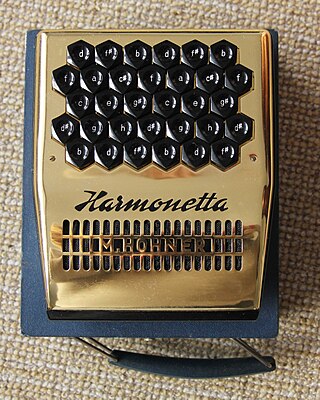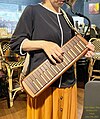The clarinet is a single-reed musical instrument in the woodwind family, with a nearly cylindrical bore and a flared bell.

The harmonica, also known as a French harp, mouth harp or mouth organ, is a free reed wind instrument used worldwide in many musical genres, notably in blues, American folk music, classical music, jazz, country, and rock. The many types of harmonica include diatonic, chromatic, tremolo, octave, orchestral, and bass versions. A harmonica is played by using the mouth to direct air into or out of one holes along a mouthpiece. Behind each hole is a chamber containing at least one reed. The most common is the diatonic Richter-tuned with ten air passages and twenty reeds, often called the blues harp. A harmonica reed is a flat, elongated spring typically made of brass, stainless steel, or bronze, which is secured at one end over a slot that serves as an airway. When the free end is made to vibrate by the player's air, it alternately blocks and unblocks the airway to produce sound.

The saxophone is a type of single-reed woodwind instrument with a conical body, usually made of brass. As with all single-reed instruments, sound is produced when a reed on a mouthpiece vibrates to produce a sound wave inside the instrument's body. The pitch is controlled by opening and closing holes in the body to change the effective length of the tube. The holes are closed by leather pads attached to keys operated by the player. Saxophones are made in various sizes and are almost always treated as transposing instruments. A person who plays the saxophone is called a saxophonist or saxist.

Woodwind instruments are a family of musical instruments within the greater category of wind instruments. Common examples include flute, clarinet, oboe, bassoon, and saxophone. There are two main types of woodwind instruments: flutes and reed instruments. The main distinction between these instruments and other wind instruments is the way in which they produce sound. All woodwinds produce sound by splitting the air blown into them on a sharp edge, such as a reed or a fipple. Despite the name, a woodwind may be made of any material, not just wood. Common examples of other materials include brass, silver, cane, and other metals such as gold and platinum. The saxophone, for example, though made of brass, is considered a woodwind because it requires a reed to produce sound. Occasionally, woodwinds are made of earthen materials, especially ocarinas.

The sheng is a Chinese mouth-blown polyphonic free reed instrument consisting of vertical pipes.

The Clavinet is an electric clavichord invented by Ernst Zacharias and manufactured by the Hohner company of Trossingen, West Germany, from 1964 to 1982. The instrument produces sounds with rubber pads, each matching one of the keys and responding to a keystroke by striking a given point on a tensioned string, and was designed to resemble the Renaissance-era clavichord.

A mouth organ is any free reed aerophone with one or more air chambers fitted with a free reed. Though it spans many traditions, it is played universally the same way by the musician placing their lips over a chamber or holes in the instrument, and blowing or sucking air to create a sound. Many of the chambers can be played together or each individually.

The tenor saxophone is a medium-sized member of the saxophone family, a group of instruments invented by Adolphe Sax in the 1840s. The tenor and the alto are the two most commonly used saxophones. The tenor is pitched in the key of B♭ (while the alto is pitched in the key of E♭), and written as a transposing instrument in the treble clef, sounding an octave and a major second lower than the written pitch. Modern tenor saxophones which have a high F♯ key have a range from A♭2 to E5 (concert) and are therefore pitched one octave below the soprano saxophone. People who play the tenor saxophone are known as "tenor saxophonists", "tenor sax players", or "saxophonists".

An electric organ, also known as electronic organ, is an electronic keyboard instrument which was derived from the harmonium, pipe organ and theatre organ. Originally designed to imitate their sound, or orchestral sounds, it has since developed into several types of instruments:

Hohner Musikinstrumente GmbH & Co. KG is a German manufacturer of musical instruments, founded in 1857 by Matthias Hohner (1833–1902). It is a subsidiary of Matth. Hohner AG. The roots of the Hohner firm are in Trossingen, Baden-Württemberg. Since its foundation, and though known for its harmonicas, Hohner has manufactured a wide range of instruments, such as kazoos, accordions, recorder flutes, melodicas, banjos, electric, acoustic, resonator and classical guitars, basses, mandolins and ukuleles.

A button accordion is a type of accordion on which the melody-side keyboard consists of a series of buttons. This differs from the piano accordion, which has piano-style keys. Erich von Hornbostel and Curt Sachs categorize it as a free reed aerophone in their classification of instruments, published in 1914. The sound from the instrument is produced by the vibration of air in reeds. Button accordions of various types are particularly common in European countries and countries where European people settled. The button accordion is often confused with the concertina; the button accordion's buttons are on the front of the instrument, where as the concertina's are on the sides and pushed in parallel with the bellows.

The pump organ or reed organ is a type of free-reed organ that generates sound as air flows past a vibrating piece of thin metal in a frame. The piece of metal is called a reed. Specific types of pump organ include the American reed organ, the Indian harmonium, the physharmonica, and the seraphine. The idea for the free reed was derived from the Chinese sheng through Russia after 1750, and the first Western free-reed instrument was made in 1780 in Denmark.
The melodica is an uncommon musical instrument in which the user blows air through a reeded keyboard. With its distinctive sound, the melodica has been used both for novelty purposes and as an instrument favored by certain performers.

The couesnophone, also known as the goofus or queenophone, is a free-reed musical instrument in a saxophone shape, patented by French instrument manufacturer Couesnon in 1924. Its reeds vibrate when the desired keys are activated and the player blows through a tube. "Best described as a mouth-blown accordion," "it sounded like a cross between a harmonica and an accordion."

The Cembalet is a type of electro-mechanical piano built by the Hohner company of Trossingen, West Germany from the late-1950s to the late 1960s, and designed by Ernst Zacharias. It was a reed-based electric piano intended for home use, and the first keyboard produced by Hohner as a piano-like instrument rather than an instrument having the sustained note of an organ. It was adopted by popular musicians for recording and performance in the early 1960s because it was portable and easy to amplify electronically.

A wind instrument is a musical instrument that contains some type of resonator in which a column of air is set into vibration by the player blowing into a mouthpiece set at or near the end of the resonator. The pitch of the vibration is determined by the length of the tube and by manual modifications of the effective length of the vibrating column of air. In the case of some wind instruments, sound is produced by blowing through a reed; others require buzzing into a metal mouthpiece, while yet others require the player to blow into a hole at an edge, which splits the air column and creates the sound.

Music technology is the study or the use of any device, mechanism, machine or tool by a musician or composer to make or perform music; to compose, notate, playback or record songs or pieces; or to analyze or edit music.

The Hohner Harmonetta is a mouth-blown free-reed instrument which was introduced by Hohner in the 1950s. It has an approximately 3-octave range, from C3 to B5.

A digital accordion is an electronic musical instrument that uses the control features of a traditional accordion to trigger a digital sound module that produces synthesized or digitally sampled accordion sounds or, in most instruments, a range of non-accordion sounds, such as orchestral instruments, pipe organ, piano, guitar, and so on. Digital accordions typically encode and transmit key presses and other input as Musical Instrument Digital Interface (MIDI) messages. Most digital accordions need to be plugged into a keyboard amplifier or PA system to hear their sounds.




























